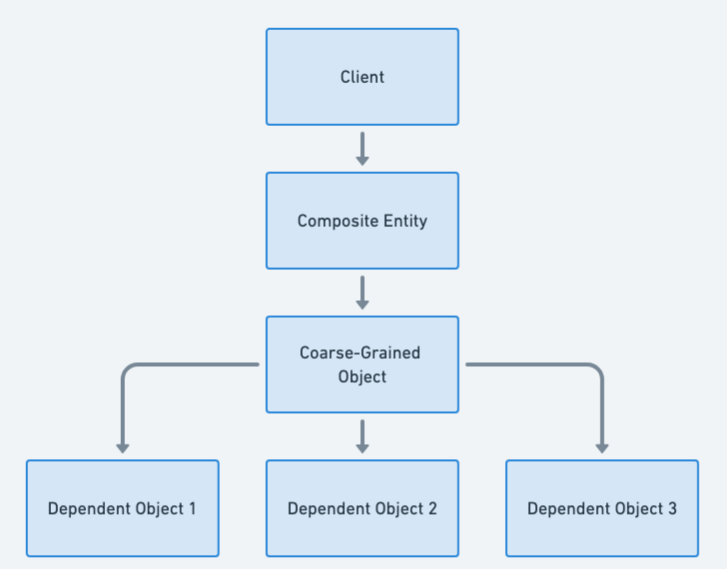Composite Entity Pattern in Java: Streamlining Persistent Object Management
Also known as
- Coarse-Grained Entity
Intent of Composite Entity Design Pattern
The Composite Entity design pattern in Java is aimed at managing a set of interrelated persistent objects as if they were a single entity. It is commonly used in enterprise applications, particularly within the context of Enterprise JavaBeans (EJB) and similar enterprise frameworks, to represent graph-based data structures within business models. This pattern enables clients to treat these complex structures as a single unit, simplifying operations and interactions.
Detailed Explanation of Composite Entity Pattern with Real-World Examples
Real-world example
Consider a university registration system where a "Student" entity is a composite entity. Each "Student" object includes several dependent objects: personal details, course enrollments, grades, and payment information. Instead of managing each of these aspects separately, the Composite Entity design pattern allows the university system to treat the "Student" as a single entity. This simplifies operations such as enrolling a student in a new course, updating grades, and processing payments, since all related actions can be managed through the composite "Student" object.
In plain words
The Composite Entity pattern in Java allows a set of related persistent objects to be represented and managed by a unified object, simplifying enterprise application design.
Wikipedia says
Composite entity is a Java EE Software design pattern and it is used to model, represent, and manage a set of interrelated persistent objects rather than representing them as individual fine-grained entity beans, and also a composite entity bean represents a graph of objects.
Flowchart

Programmatic Example of Composite Entity in Java
For a console, there may be many interfaces that need to be managed and controlled. Using the composite entity pattern, dependent objects such as messages and signals can be combined and controlled using a single object.
We need a generic solution for the problem. To achieve this, let's introduce a generic Composite Entity Pattern.
public abstract class DependentObject<T> {
T data;
public void setData(T message) {
this.data = message;
}
public T getData() {
return data;
}
}
public abstract class CoarseGrainedObject<T> {
DependentObject<T>[] dependentObjects;
public void setData(T... data) {
IntStream.range(0, data.length).forEach(i -> dependentObjects[i].setData(data[i]));
}
public T[] getData() {
return (T[]) Arrays.stream(dependentObjects).map(DependentObject::getData).toArray();
}
}The specialized composite entity console inherit from this base class as follows.
public class MessageDependentObject extends DependentObject<String> {
}
public class SignalDependentObject extends DependentObject<String> {
}
public class ConsoleCoarseGrainedObject extends CoarseGrainedObject<String> {
@Override
public String[] getData() {
super.getData();
return new String[] {
dependentObjects[0].getData(), dependentObjects[1].getData()
};
}
public void init() {
dependentObjects = new DependentObject[] {
new MessageDependentObject(), new SignalDependentObject()};
}
}
public class CompositeEntity {
private final ConsoleCoarseGrainedObject console = new ConsoleCoarseGrainedObject();
public void setData(String message, String signal) {
console.setData(message, signal);
}
public String[] getData() {
return console.getData();
}
}Now managing the assignment of message and signal objects with the composite entity console.
public App(String message, String signal) {
var console = new CompositeEntity();
console.init();
console.setData(message, signal);
Arrays.stream(console.getData()).forEach(LOGGER::info);
console.setData("Danger", "Red Light");
Arrays.stream(console.getData()).forEach(LOGGER::info);
}When to Use the Composite Entity Pattern in Java
- Useful in Java enterprise applications where business objects are complex and involve various interdependent persistent objects.
- Ideal for scenarios where clients need to work with a unified interface to a set of objects rather than individual entities.
- Applicable in systems that require a simplified view of a complex data model for external clients or services.
Real-World Applications of Composite Entity Pattern in Java
- Enterprise applications with complex business models, particularly those using EJB or similar enterprise frameworks.
- Systems requiring abstraction over complex database schemas to simplify client interactions.
- Applications that need to enforce consistency or transactions across multiple persistent objects in a business entity.
Benefits and Trade-offs of Composite Entity Pattern
Benefits:
- Simplifies client interactions with complex entity models by providing a unified interface.
- Enhances reusability and maintainability of the business layer by decoupling client code from the complex internals of business entities.
- Facilitates easier transaction management and consistency enforcement across a set of related persistent objects.
Trade-offs:
- May introduce a level of indirection that could impact performance.
- Can lead to overly coarse-grained interfaces that might not be as flexible for all client needs.
- Requires careful design to avoid bloated composite entities that are difficult to manage.
Related Java Design Patterns
- Decorator: For dynamically adding behavior to individual objects within the composite entity without affecting the structure.
- Facade: Provides a simplified interface to a complex subsystem, similar to how a composite entity simplifies access to a set of objects.
- Flyweight: Useful for managing shared objects within a composite entity to reduce memory footprint.